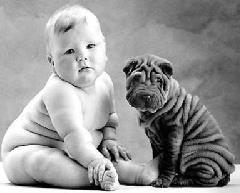by Susan Spice
There won’t be another years as intense as your baby’s first in terms of growth and development. And there may not be another as intense for you because your baby is going to transform you into a parent – – his parent. Here’s a look at the amazing transformation from birth to first birthday.
0-3 months: your baby unfolds
At birth, your baby’s body will be quite tucked in – arms flexed, hands in tiny fists, legs and feet drawn up, and a head that lolls to one side. Muscle control moves from the top down in infancy.
By three months, he’ll be able to lift his face when lying on his stomach and hold his head up when propped on his arms.
His hands gradually unfurl, and your baby begins to notice that his feet and hands are attached to him. By three months, he’ll swipe at a toy, grasp and shake it – the development of hand-eye coordination.
Babies learn through all their senses.
Newborns:
Prefer sweet tastes like breast milk.
Can distinguish mother’s scent within days of birth.
Turn to and are calmed by familiar voices.
Focus within eight to 12 inches, about the distance between your face and his when he nurses.
Babies come with a cry designed to galvanize your attention, but by the second month, your baby will start to make other sounds – long strings of oohs and aahs – what experts call protoconversation.
Babies are designed for face to face interaction that has a turn taking structure. If you purse you lips or raise your eyebrows and wait, you baby will try it too. One day, between four and eight weeks, you will smile at your baby, and his face will bloom into his first true smile.
Your role:
Your baby is getting used to the world, to having a bigger space around him. His perception roughly matches his visual range.
Whenever you can, dim the lights, slow things down, keep your baby close, spend time gazing, cooing, rocking, feeding.
When your baby is awake and alert, notice how intently he gazes at whatever is close enough to focus on. Let him study your face, or move a boldly patterned object slowly across his line of vision.
Your baby is soaking up the rhythms and sounds of language. Sing to him; tell him about what you’re doing.
Cope kit: Crying
Crying tends to peak at about 2 months and then tapers off by 4 or 5 months. One to three hours a day of crying is average, but a few unhappy souls will cry inconsolably for hours. Carrying your baby more may reduce the overall amount of crying. Here are some other things to try.
Feed your baby. Infants have tiny stomachs and need to ear often, around the clock.
Recreate the womb. Loud shushing or white noise, rhythmic movement and swaddling are time honored baby soothers.
While a tiny crying baby shouldn’t be left alone, you may need a break- every parent needs support. If you feel very frustrated or angry during a crying jag, put your baby in a safe place like her crib, and leave the room until you feel calmer.
3-6 months: the settled baby

baby first year
Your baby is gaining more control through her middle. At three months, if you hold her in a sitting position, her head will slump forward; gradually she’ll be able to hold up her head and shoulders and sit with support. She will soon figure out how to roll front to back and later, the other way.
She’s found her hands and feet by now and her developing hand-eye coordination means she can reach for and drag objects to her. Her developing vision allows her to focus on objects further away and track her big brother zooming by!
By five months, she’ll begin to add consonants to her repertoire of sounds – b, d, m, n, w, j come first because they use the same muscles as sucking – and a few weeks later, she’ll start putting it all together – bababa. Mamama. Receptive language is in active development at this stage, a six month old knows what bye-bye means, even though she won’t say it yet.
Your baby, awake more now, is easier to soothe and more social. She knows her family as her special people, and may be more reserved with strangers; those full body smiles will be reserved for you. She actively engages you, cooing, babbling and shrieking with delight when you’re nearby.
Your role:
Sing and talk to your baby, provide lots of physical contact, play on the floor and respond to her attempts to communicate.
Let your baby watch the action. A little bouncy seat is great for this, and so is a front carrier when you’re out walking.
Show and name objects and let your baby experience all kinds of textures, colors and shapes.
Add something new to your baby’s day, like the sensation of water trickling on her belly at bath time. Babies thrive on novelty. This morning you tickled her toes during a diaper change; this afternoon you might pedal her legs.
Cope kit: hungry baby?
Sometimes parents are anxious t start solid food early, thinking this will help the baby sleep longer at night. Or they see that their baby is watching them eat at the table, and conclude that the baby is hungry. But breast feeding is still the best nutrition for babies until about six months.
A baby who seems really hungry is probably going through a growth spurt. It’s better to nurse more often than to offer table foods too soon. And don’t push him to forgo night feedings at this stage: some active babies get most of their calories during the night.
6-9 months: making connections
A baby at this stage is extremely purposeful. He has more control over the upper half of is body, can push up on his hands when he’s on his tummy and, by nine months, can sit without support for a few minutes. He may so the bum shuffle or roll across the floor. He will love standing, with support, and bouncing on your lap.
His hands are working well now; he can transfer an object from one hand to the other, clap and bang objects together.
As you introduce new foods, follow his lead. He’ll reach for what he enjoys and turn away when he’s less keen.
Your baby will imitate and can anticipate the actions of others, and follow simple instructions, such as waving bye-bye to his brother, when you prompt him. He’s beginning to understand the meaning of words he hears often: diaper, cat, his name. between seven and nine months, babies use what Maria Legerstee calls declarative pointing. He sees something interesting and will say ah, the precursor to the use of real words.
Long periods of fussiness have usually pretty much gone and he’s able to express his feelings quite clearly: frustration when he can’t reach a toy, joy in seeing you. He will work to capture your attention, often by making sounds, and has begun to develop some control over his feelings and actions. If he wants to be picked up, he’ll let you know by reaching up to you.
Separation anxiety often appears at about eight months. It arises out of your baby’s growing attachment to you, and his understanding that you continue to exist even when you’re out of sight. While challenging to deal with, it’s actually a sign of healthy emotional development.
Your role:
Give your baby lots of opportunity to practice his growing physical skills.
If he is trying to climb onto the cough, pile a few cushions on the floor for him with a favorite toy at the top.
Read, sing and share finger plays.
Help him explore object permanence. If you hide a toy partially in view, he may look for it. Or play peekaboo!
Reassure him when goodbye is hard and help him connect with the person who will care for him. Don’t sneak off; instead, use words you’ll repeat every time: mommy always comes back.
Cope kit: night waking
You can barely remember what a full night’s sleep feels like. Is it time to encourage your baby to sleep longer stretches at night?
Bedtime routine helps the baby associate certain activities with sleep time: bath, story, lullaby, rocking or nursing. If you rock and nurse your baby to sleep, try to put her sown before she’s completely zonked out. A slight jostle as she goes into the crib any help her learn to fall asleep on her own.
Is it a slight arousal or real crying? Sometimes parents wake a baby who might have returned to sleep on her own. If you’re sure she needs you, attend to your baby quickly and be very boring.
9-12 months: on the move
Your baby is really pushing for mobility now. A few will walk at nine or 10 months, but anytime up to 14 months or so is within the range of normal. The important large motor milestones are sitting, standing and then walking; along the way, babies find very inventive ways to get around. Some crawl; others do the bear walk or skip this stage altogether. She will be eager to practice standing and pull herself up to cruise by hanging onto furniture.
She’s got a pincer grip now: the ability to grasp a small object with her thumb and index finger. She will begin to use objects as they were intended – drinking with a cup, combing her hair.
By 12 months, babies can produce most of the vowel sounds and about half of the consonants. She may not have a recognizable word yet, bur her babbling will have all the inflection and tome of fluent speech. She will understand such requests as “don’t touch, or find the ball” and may use exclamations, such as oh, or her own brand of words to name things. When you read a book together, she will be able to point to the bunny or the dog.
It’s beginning to dawn on your baby that she is a separate person: she can feed herself express her preferences about clothing – perhaps with a no. but she’s still little and all that striving will sometimes lead to frustration. When that happens, see things from her point of view. Big feelings can overwhelm her and she needs your help to cope with them.
The secure attachment the two of you have built over the past year means your baby confidently explores her world knowing you are there to help if she’s overwhelmed. You’ll see this as she sets out to crawl across a room, pausing to see that you’re there. She still needs you close by, encouraging her exploration.
Your role:
Let your baby do things herself as much as possible.
Provide a spoon at mealtime. Ask her to find her shoes or turn the page.
Something to push like a box full of blocks helps her balance as she learns to walk.
Give her toys and household objects for practice using her hands – stacking cups, fat crayons, a squishy sponge.
If your baby has a comfort object- a stuffie, a blanket – respect her fondness for it. These loveys help babies cope with stress: falling asleep on their own, saying goodbye, spending time with a sitter.
Cope kit: keeping baby safe
A mobile baby means you need to start thinking about baby proofing. The key to keeping him safe is to stay one step ahead of him. If he’s creeping around, get down on floor and take his view. That floor lamp with its electrical cord to the wall socket may have to go. Are there sharp corners on your coffee table or heavy objects on book shelves that pose a danger to him?
But keep things balanced: too many gates or too much time in a playpen may keep him safe, but will stifle his drive to explore. Of course, the best baby proofing aid is you, closely supervising your baby.
Find out unique baby gift sets here.




